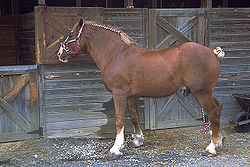 Colors normally are a type of light chestnut sometimes called a "sorrel," with a flaxen mane and tail.
Colors normally are a type of light chestnut sometimes called a "sorrel," with a flaxen mane and tail.
On average the Belgian will grow to weigh slightly over 1 ton or 2,000 pounds. Currently, the world's tallest Belgian Draft is Radar, a gelding foaled in 1998 in Iowa. He stands at 19.3½ hands high, which means he is 6 feet 7½ inches (2.02 metres) tall at the withers, and weighs over 2,400 lb (1,090 kg).
Belgians have a high occurrence of junctional epidermolysis bullosa (JEB), an inherited genetic disorder that causes newborn foals to lose large areas of skin and have other abnormalities, normally resulting in euthanasia. A study conducted in 2001-2003 found that 17.1% of tested Belgians in the US and Canada were carriers, including 13.5% of stallions and 28.9% of mares. If carriers are not mated, JEB can be avoided, and scientists are studying the disease further in the hope of completely eliminating it. The Belgian breed registry requires JEB testing. Belgians have also been identified to be at risk for chronic progressive lymphedema, a chronic progressive disease that includes symptoms of progressive swelling, hyperkeratosis and fibrosis of distal limbs. The disease is similar to chronic lymphedema in humans.
The world's largest Belgian Horse was named Brooklyn Supreme, who weighed 3,200 pounds (1,450 kg) and stood at 19.2 hands (1.98 m).
Belgian horses are able to pull tremendous weights. At the National Western Stock Show in Denver, Colorado, a team of two horses in the Heavyweight class pulled 17,000 pounds a distance of 7 ft 2 in (7,700 kg a distance of 2.18 m). The team of Belgians weighed 4,800 pounds (2,200 kg). At the Iowa State fair, the heavyweight champions in the pulling contest pulled 14,600 pounds the complete distance of 15 ft (6,690 kg, 4.6 m). The team consisted of one Belgian and one Percheron and weighed 3,600 pounds (1,600 kg).
